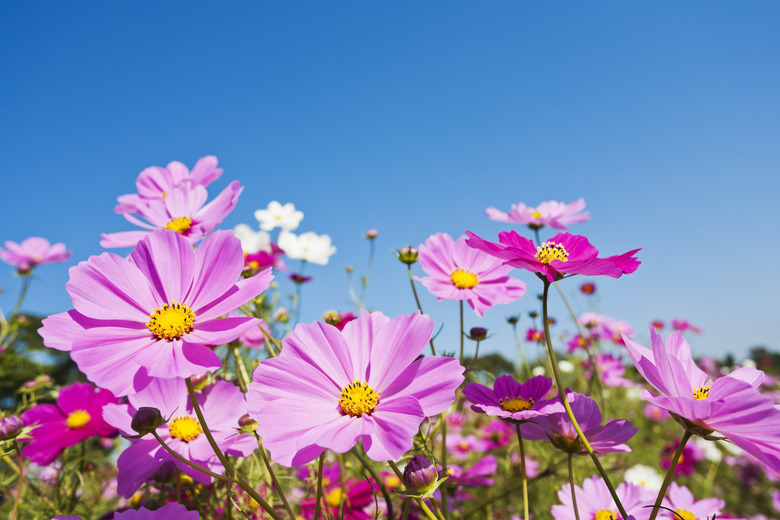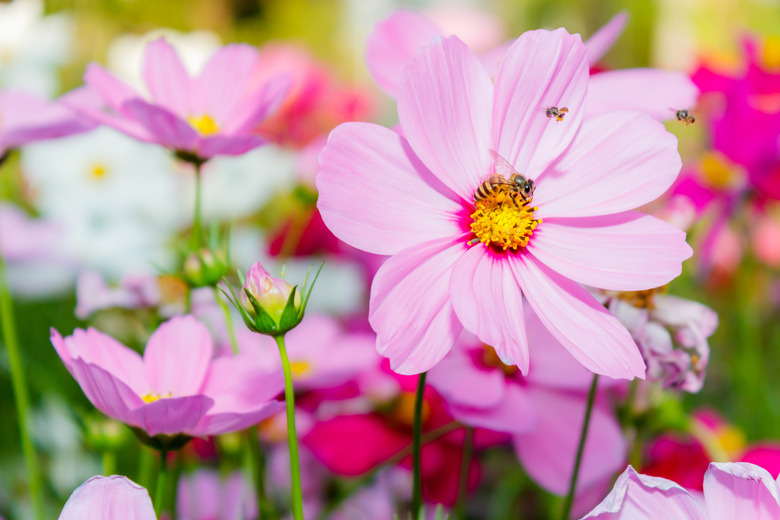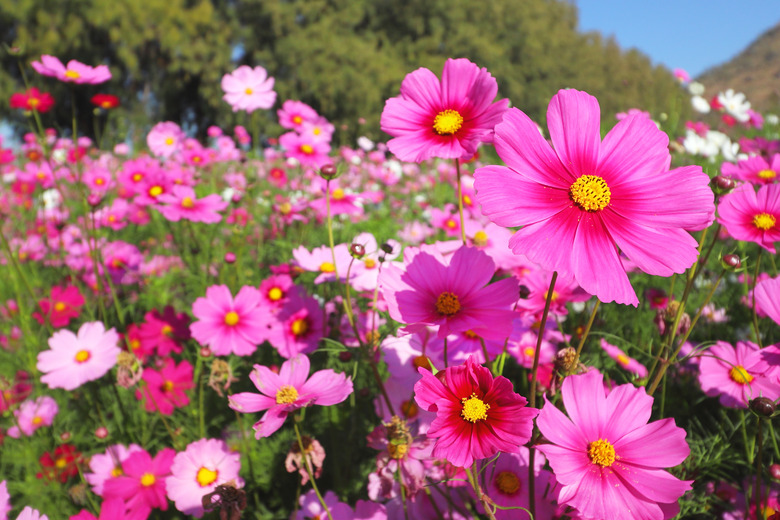How To Grow Cosmos
We may receive a commission on purchases made from links.
Some people want to spend a lot of time in their garden to cultivate a perfectly manicured display tailored exactly to their tastes, but others just want some pretty blooms without investing too much time or effort. For those in the latter group, cosmos (Cosmos spp.) are an excellent choice. Although there are at least 20 species of cosmos, two of these species are the ones most often grown by home gardeners — tall or garden cosmos (Cosmos bipinnatus) and sulphur cosmos (Cosmos sulphureus).
These lovely flowers usually grow to heights between 1 and 4 feet tall depending on the species and cultivar, with some reaching heights of up to 6 feet. The tall, thin stems have delicate, lacy foliage and grow one or more silky, 3- to 5-inch-wide, daisylike flowers in a wide selection of colors, including pink, red, maroon, orange, yellow and white.
When cosmos flowers bloom in the summer, they attract all sorts of pollinators to your garden, including bees, hummingbirds and butterflies. Best of all, they are easy to grow even in poor soil conditions, require practically no maintenance, are drought resistant once established and self-sow so you can enjoy the blooms year after year with no additional effort.
Best Uses for Cosmos
Best Uses for Cosmos
Cosmos, which means "beautiful," is a member of the sunflower family (Asteraceae), which also includes sunflowers, dahlias, chrysanthemums, marigolds, daisies and heleniums. The plant is native to Mexico and was first brought to Europe by explorers in the 1500s. Interestingly, it didn't make its way to the United States until the early 1800s, when it was brought across the Atlantic from England.
Cosmos does well in garden beds as well as planters, and the fresh-cut flowers stay unwilted for up to a full week in a water-filled vase. It's worth noting that while these flowers are fairly hands off, some taller cultivars may require staking, especially in windy areas, although they can instead be grown close together or against walls or fences to provide additional support.
How to Grow Cosmos
How to Grow Cosmos
- Common Name: Cosmos
- Botanical Name: Cosmos spp.
- When to Plant: Early spring
- USDA Zones: Depending on species, zones 7-11 (perennials); 2-11 (annuals)
- Sun Exposure: Full sun
- Soil Type: Lightweight,
slightly alkaline and low in nutrients - When it's in Trouble: Few blooms, weak stems, stunted growth, spots
on leaves or stems, discolored stems and foliage, misshapen flowers - When it's Thriving: Lacy foliage, tall stems and ample blooms throughout the summer
Starting Cosmos From Seed
While it's possible to buy cosmos plants as seedlings, it's preferable to grow them from seeds because the process is so simple and inexpensive. When sowing outdoors, start seeds after the danger of frost has passed, but when starting seeds indoors, you can start around a month before the last frost date to get earlier blooms.
To sow seeds outdoors, choose a spot that gets at least six hours of sun per day that is protected from strong winds. Don't bother amending the soil, as rich soil actually discourages blooms. While the plants grow reasonably fast and can start blooming within a month and a half, their peak bloom period doesn't occur until late summer after the days start to become shorter again.
Sow seeds about 1/4 inch deep and approximately 1 to 2 feet apart based on the spacing recommendations for your specific cultivar. If you are growing a tall variety and don't plan on staking your cosmos, you can space them slightly closer than recommended so the plants can provide support to one another, or you can plant them beside fences, trees or other structures for additional support.
To start seeds indoors, sow them in trays or small pots and move them outdoors or into planters at least 5 inches in diameter after the cosmos plants are at least 3 inches tall.
Whether sowing seeds indoors or outdoors, water regularly after seeding but never overwater. While cosmos don't like excessive fertilizer, adding a small amount of fertilizer immediately after planting can increase the number of flowers later. Use the minimum recommended amount of bone meal, fertilizer for blooming plants or other fertilizer low in nitrogen, which promotes the growth of foliage but discourages flower production. While plants grown in the ground should not be fertilized after this, cosmos grown in containers do not get as many nutrients and can be fertilized every month or so with a water-soluble fertilizer.
Cosmos will continue blooming throughout summer, and you should either deadhead faded flowers or cut off young blooms just after they open to enjoy the fresh-cut flowers. This will help prolong the bloom season and increase the number of flowers. If you want to have more cosmos the following year, stop deadheading or cutting blossoms in fall to allow the spiky-brown seeds to spread and self-sow.
In What Zone Does Cosmos Grow Best?
In
What Zone Does Cosmos Grow Best?
Cosmos is native to arid, warm regions, but it can do surprisingly well in a wide variety of conditions provided it doesn't get too cold. In fact, these plants can thrive as annuals in USDA zones 2 through 11. They will naturally prosperr in hot climates, but no matter where they have been planted, the tall height of many types means they should be protected from strong winds or staked.
While incredibly hardy in other ways, cosmos will not survive through winter frosts, but because they are such avid self-seeders, they will likely grow back the next year as long as you allow at least some of the flowers to drop their seeds.
When Should You Plant Cosmos?
When Should You Plant Cosmos?
Because cosmos plants don't like cold weather, they should only be planted after the threat of frost has completely passed. That being said, if you want blooms a bit earlier in the year, you can start the seeds indoors up to five weeks before the last frost date and transplant the seeds when they reach 3 inches tall. This will let you experience blooms a month or so earlier than you would if you sowed directly outside.
Soil, Sunlight and Water Recommendations for Cosmos
Soil, Sunlight and Water Recommendations for Cosmos
One of the greatest things about growing cosmos plants is that they are so adaptable and can grow in even the poorest of soils. That being said, they do best with slightly alkaline, lightweight soil that is a little poor in nutrients. In fact, cosmos actually does poorly in overly rich soil, which will result in too few blooms and weak stems that will easily collapse. This is also why you should rarely fertilize cosmos plants and avoid using fertilizer that is high in nutrients.
Because cosmos is native to warm climates, it prefers hot weather and dry soil over shade and excess moisture. While the plants can still grow in partial shade in warm regions, it ideally wants a minimum of six hours of direct sunlight per day to maximize flower production. Seeds need moisture to germinate, but once the plant starts growing, it is drought tolerant. Of course, cosmos will grow more flowers when watered regularly. Always allow the soil to dry out before watering or you could waterlog the roots.
How to Winterize Cosmos
How to Winterize Cosmos
Cosmos may do well in particularly hot and arid conditions, but they are not big fans of cold weather. Of course, many of these plants are annuals that will die off in winter anyway. Whether your cosmos are annuals or perennials, if left to self-seed, you will almost always be rewarded with more cosmos plants the following year. That being said, if you have one of the perennial species and don't want to let it die in the winter, you can save it by bringing it indoors.
Chocolate cosmos (Cosmos atrosanguineus, zones 7-9) is an example of a perennial cosmos that grows from tubers. If you grow it in a container, you can just move it indoors for winter. But when it comes to plants grown in the ground, if you live outside its hardiness range, you'll need to cut off the stems and foliage as soon as the leaves are blackened after the first frost in your area.
Next, gently remove the tubers from the soil, wipe away any excess dirt and dry them in a frost-free shed. Wrap the roots with a wet towel, set them in pots and store them somewhere dark and cool but not freezing. Add a little water every few weeks but only allow the towels to slightly dampen to prevent root rot.
About a month before the last frost date in your area, plant the tubers in pots and place them in a warm, bright area to stimulate growth. Once they've sprouted again, take them outside during the daylight hours and bring them back in at night for a week in order to harden off the plants before replanting them outdoors.
Common Pests and Other Problems for Cosmos
Common Pests and Other Problems for Cosmos
These plants are rarely affected by pests or diseases, but they can be targeted by aphids, thrips and lygus bugs, all of which suck sap from the plant and can stunt its growth. Aphids look like little white or black spots on the leaves or stems. Thrips are smaller than aphids and often look like tiny black specks on the plant's stem. Lygus bugs have x-shaped wings on their back and are a little bigger than aphids. All of these pests can be treated effectively with insecticidal soap.
Common Diseases for Cosmos
Common
Diseases for Cosmos
Cosmos plants can be infected by a number of common plant diseases, including fusarium wilt, powdery mildew, bacterial wilt and aster yellows. Fusarium wilt and powdery mildew are both fungal diseases. Fusarium wilt causes discoloration in the stems and foliage and pink masses on the roots. This disease will eventually kill any affected plant and cannot be treated once a plant is infected. When you discover fusarium wilt, remove and destroy all affected plants.
Powdery mildew is recognizable by the distinctive powdery coating it leaves on the leaves. If discovered, remove the affected leaves and treat all plants in the area with a fungicide.
Fungal diseases such as fusarium wilt and powdery mildew may be prevented by ensuring plants are adequately spaced and not overwatered. Always ensure soil is mostly dry before watering your plants, and thin out plants to the recommended spacing to reduce the risk of fungal infections.
Bacterial wilt is a bacterial disease that causes stems to wilt where they connect to the rest of the plant. Aster yellows is a disease spread by leafhoppers that targets all members of the sunflower family (Asteraceae). You'll know you have a problem with these diseases if your flowers begin to die after first growing somewhat stunted and misshapen or if your foliage is developing yellow splotches. There is no cure for either bacterial wilt or aster yellows, and the only solution is to dig up and destroy all affected plants before they infect other plants in your garden.
References
- Gardening Know How: Cosmos Flower Diseases – Reasons Cosmos Flowers Are Dying
- Daily Mail: With Lovely Ferny Foliage and Elegant Blooms in Any Colour You Like That'll Keep on Flowering for Months, Cosmos Are Just Out of This World, Says Monty Don
- Gardening Know How: All About Old-Time Cosmos Flowers
- Burpee: All About Cosmos
- The Old Farmer's Almanac: Growing Cosmos


